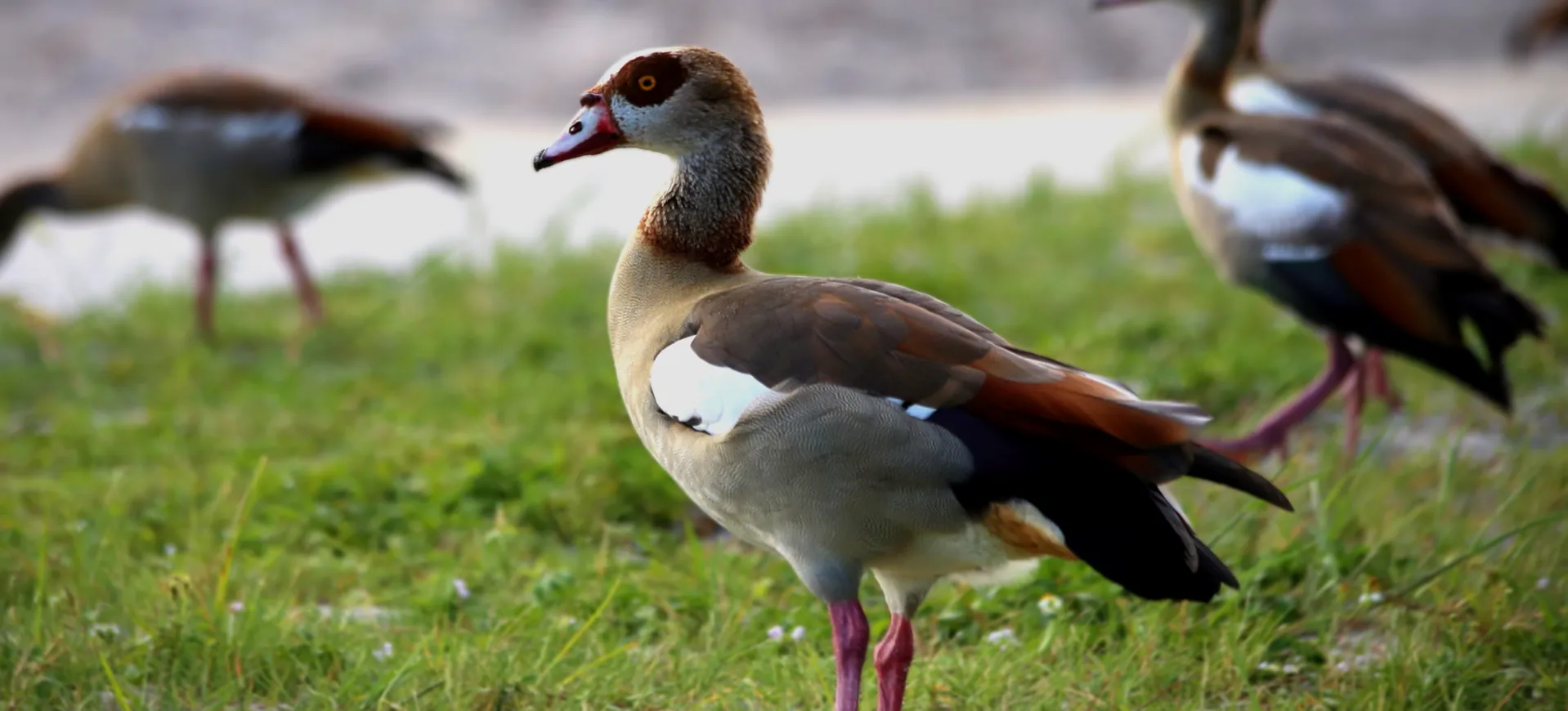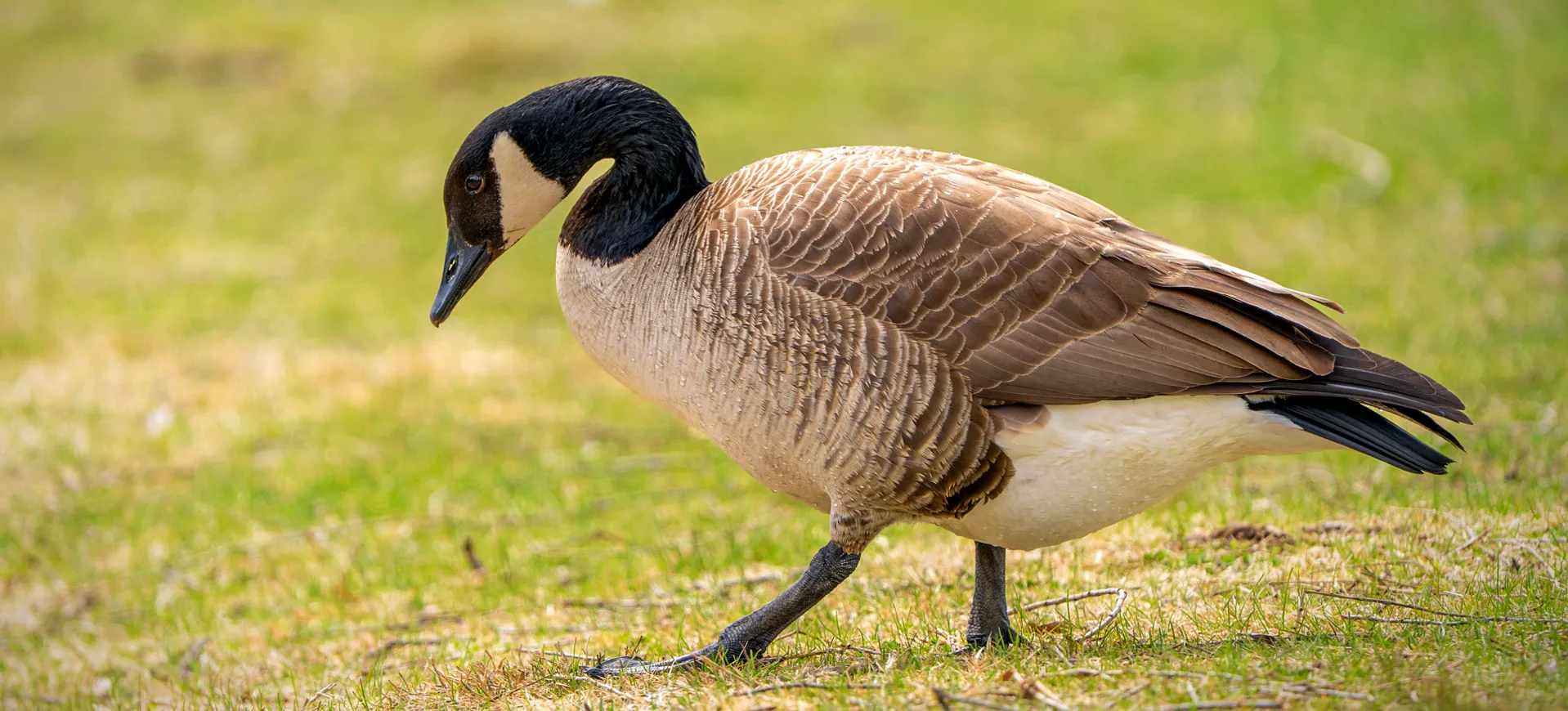Overview
The Common Merganser (Mergus merganser) is a large, distinctive waterfowl known for its sleek profile and expert swimming ability. Males have a striking appearance with a dark green head, white body, and a narrow, hooked red bill, making them easily identifiable. Females and juveniles are more subtly colored, featuring gray bodies with a characteristic rusty-cinnamon head and a shaggy crest, contrasting with the males’ more vivid plumage. These birds are highly adapted to aquatic environments, spending much of their time in freshwater lakes, rivers, and coastal waters, where they dive and swim underwater to catch fish, their primary food source.
Common Mergansers are migratory, breeding in the northern regions of North America, Europe, and Asia and wintering further south where waters remain unfrozen. They prefer clear waters for their excellent visibility, which aids in hunting fish, and nest in tree cavities or nest boxes close to water. The species plays a significant role in controlling fish populations, making them an integral part of their ecosystem. Despite habitat loss and pollution threats, Common Mergansers generally maintain stable populations, thanks partly to their wide distribution and adaptability to different aquatic habitats.
Conservation efforts for Common Mergansers focus on protecting their aquatic habitats and nesting sites from degradation and disturbance. These efforts include monitoring water quality, conserving forests around breeding areas, and installing nest boxes to compensate for the loss of natural nesting sites. The birds’ dependence on specific habitats for breeding and feeding underscores the importance of integrated conservation strategies that address local and migratory needs. With ongoing environmental changes, the Common Merganser serves as an indicator species for the health of freshwater ecosystems, highlighting the need for sustainable management of water resources.
Taxonomy
Kingdom
Phylum
Class
Order
Family
Genus
Species
Type
Physical Description:
The Common Merganser is noted for its long, slender body and aerodynamic shape, which is optimized for both flying and swimming. Males in breeding plumage are particularly striking, with their crisp white bodies contrasted by dark green heads and a splash of black on the back. The serrated edge of their long, narrow bill is a unique adaptation that allows them to grasp slippery fish with ease. In flight, they present a powerful and graceful silhouette, with strong, rapid wingbeats propelling them over long distances.
Females are distinguishable by their rusty cinnamon heads with a distinctive crest, which can be raised or lowered. Both sexes have bright red feet and bills, adding a flash of color to their otherwise muted or contrasting plumages. During the non-breeding season, males molt into a more subdued plumage that resembles the females’, though they retain their distinctive white wing patches. The Common Merganser’s streamlined body and specialized bill reflect its evolutionary adaptations to aquatic life, hunting fish with remarkable efficiency.

Lifespan: Wild: ~5 Years || Captivity: ~13 Years

Weight: Male: 2.5-4.5 lbs (1.1-2.0 kg) || Female: 2.0-3.5 lbs (0.9-1.6 kg)

Length: Male & Female: 23-28 inches (58-70 cm)

Wingspan: Male & Female: 34-36 inches (86-91 cm)

Top Speed: 50 mph (80 km/h) in flight
Characteristic:
Native Habitat:
Common Mergansers are found in a variety of freshwater habitats, ranging from small streams and rivers to large lakes and reservoirs. They have a preference for cold, clear waters where they can easily spot and pursue fish. During the breeding season, they are drawn to forested areas with access to water, where they can find suitable nesting cavities. The presence of ample nesting sites, such as tree cavities or nest boxes, is essential for their reproductive success.
These ducks are well adapted to cold climates, with their breeding range extending into the boreal forests of the northern hemisphere. They rely on the availability of open water for feeding, which influences their migratory patterns and winter habitat selection. Protecting these natural habitats from development and pollution is vital for the conservation of Common Mergansers, ensuring they have the necessary resources to breed, feed, and thrive throughout their range.
Climate Zones:
Biogeographical Realms:
Continents:
Countries:
Diet:
Diet & Feeding Habits:
Common Mergansers are primarily piscivorous, with a diet consisting almost entirely of fish. They are skilled hunters, diving and swimming underwater to chase down their prey with agility and speed. The serrated edges of their bills are perfectly adapted for gripping slippery fish, a trait that sets them apart from other waterfowl. In addition to fish, their diet can include aquatic invertebrates, amphibians, and small mammals, highlighting their opportunistic feeding behavior.
These birds often hunt in groups, using teamwork to corral fish, making it easier to catch them. This social hunting strategy not only increases their efficiency but also strengthens social bonds within flocks. The importance of clean, clear waters for their hunting underscores the impact of pollution and habitat degradation on their feeding habits. Conservation of aquatic habitats is crucial for maintaining healthy populations of Common Mergansers, as it ensures the availability of their food sources and supports the overall biodiversity of freshwater ecosystems.
Mating Behavior:
Mating Description:
Common Mergansers are monogamous, with pairs forming during the winter or early spring before arriving at breeding grounds. Courtship displays include elaborate behaviors such as head-bobbing, wing-flapping, and vocalizations, serving to strengthen pair bonds and ensure mate selection. Once a pair has formed, they seek out a nesting site, often returning to the same area or even the same nest if it was successful in previous years. The female is solely responsible for egg incubation, laying a clutch of 6 to 12 eggs, which she incubates for about 28-35 days.
The male typically stays with the female until incubation begins, at which point he may leave to join other males. After hatching, ducklings are precocial and ready to leave the nest within a day or two, following their mother to water, where they learn to feed and swim. This early independence is crucial for their survival, as it reduces vulnerability to predators. The care provided by the female during this time is vital, as she leads her brood to feeding areas and teaches them how to forage, ensuring their growth and development.
Reproduction Season:
Birth Type:
Pregnancy Duration:
Female Name:
Male Name:
Baby Name:
Social Structure Description:
Common Mergansers exhibit a complex social structure, with behaviors varying throughout the year. During the breeding season, they are primarily monogamous and territorial, with pairs defending nesting sites and surrounding areas. Outside of the breeding season, they form large flocks, sometimes numbering in the hundreds, which can include individuals of various ages and both sexes. These flocks engage in collective foraging and migratory behaviors, demonstrating the importance of social interactions for their survival.
The social dynamics of Common Mergansers facilitate efficient hunting and protect against predators. In winter, mixed-species flocks are common, allowing mergansers to interact with other waterfowl, sharing resources and habitats. Understanding the social structure of Common Mergansers is crucial for conservation planning, as it influences their habitat requirements and behaviors. Protecting communal roosting and feeding areas is as important as preserving individual nesting sites, ensuring the species can maintain its complex social structure throughout the year.
Groups:
Conservation Status:
Population Trend:
The global population of Common Mergansers is considered stable, though certain regions may experience fluctuations due to environmental pressures and habitat changes. Their wide distribution and generalist nature have helped buffer the species against localized declines. However, ongoing monitoring is essential to ensure that populations remain healthy, especially in the face of increasing water pollution, habitat loss, and climate change. Conservation efforts that focus on protecting aquatic habitats and ensuring the availability of clean, clear waters are crucial for the continued success of Common Mergansers.
In some areas, nest box programs have been implemented to provide additional nesting sites, addressing the shortage of natural cavities. These efforts have been successful in supporting local populations, demonstrating the effectiveness of targeted conservation strategies. Public education and awareness campaigns also play a role in conservation, promoting the protection of waterways and the importance of biodiversity. The stable status of the Common Merganser reflects the success of conservation measures to date, but continued vigilance and adaptive management are necessary to address future challenges.
Population Threats:
The primary threats facing Common Mergansers include habitat loss and degradation, particularly from water pollution, deforestation, and the development of shorelines. Industrial activities and agricultural runoff can lead to water contamination, affecting the quality of their feeding and breeding grounds. Climate change poses an additional threat, potentially altering migratory patterns and affecting the availability of open water and fish populations. Disturbance from recreational activities in sensitive breeding areas can also impact their success in raising offspring.
Effective management of aquatic ecosystems and stricter regulations on pollutants are essential for mitigating these threats. Conservation strategies must also address the impacts of climate change, ensuring that Common Mergansers have access to suitable habitats throughout their migratory range. Protecting the natural environments that support their prey is equally important, as healthy fish populations are crucial for their survival. Collaborative efforts between conservation organizations, governments, and local communities are key to addressing the complex challenges faced by Common Mergansers.
Conservation Efforts:
Conservation efforts for Common Mergansers are focused on habitat protection, pollution control, and the enhancement of breeding sites. Protected areas and wildlife refuges provide critical habitats where mergansers can breed, feed, and migrate safely. Efforts to improve water quality through pollution reduction initiatives benefit not only mergansers but also a wide range of aquatic species. Nest box programs have proven effective in increasing available nesting sites, helping to offset the loss of natural tree cavities due to deforestation or development.
Collaboration with local communities and stakeholders is essential for the successful implementation of conservation measures. Educational programs that raise awareness about the importance of clean, healthy waterways can lead to greater community involvement in conservation efforts. International cooperation is also crucial, as Common Mergansers migrate across borders, requiring concerted efforts to protect their habitats along migratory routes. Ongoing research and monitoring contribute to a better understanding of their ecology, informing conservation strategies and ensuring that actions taken are based on sound scientific knowledge.
Additional Resources:
Fun Facts
- Common Mergansers are sometimes referred to as “sawbills” due to the serrated edges of their bills, which are ideal for catching fish.
- They are excellent divers, capable of staying underwater for up to 2 minutes while pursuing prey.
- Merganser ducklings can swim and dive within a day of hatching, showcasing their remarkable adaptation to aquatic life.
- The green sheen of the male’s head is so vivid it can appear almost black in certain lighting conditions.
- Despite their prowess in the water, mergansers can be somewhat awkward on land due to their large webbed feet positioned far back on their bodies.
- Common Mergansers have a quiet demeanor, often communicating through soft calls that are usually only heard at close range.
- They play an important role in controlling fish populations, particularly in freshwater ecosystems.
- The nesting success of Common Mergansers can be significantly improved with the provision of artificial nest boxes, highlighting the impact of human intervention in wildlife conservation.
- In some cultures, the Common Merganser is considered a symbol of cleanliness and purity, owing to its preference for clear, unpolluted waters.



















































































